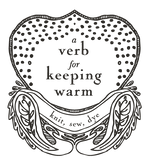




One reason I am so excited for the book is that it gives me the urgency to conduct experiments I've been wanting to do for years - in a methodical manner. This week, we've been focused upon the process of scouring, mordanting, and natural dyeing cotton fabric. There are many different ways of doing each of these steps. We would like to ascertain the pros and cons of each way.
In our experiment, we have 4 approaches of scouring:
1. none
2. soda ash (washing soda)
3. snythrapol
4. regular Trader Joe's detergent
Then, we moved to the mordant pots where we have 9 approaches:
1. none
2. aluminum sulfate
3. aluminum acetate
4. walnut
5. myrobalan
6. walnut and aluminum sulfate
7. myrobalan and aluminum sulfate
8. walnut and aluminum acetate
9. myrobalan and aluminum acetate
Finally, we have moved to the dyepots where we put a sampling of each of the above into two pots: logwood and madder.
An important part of natural dyeing is understanding how much you need of each ingredient for it to be effective in terms of lightfastness and opacity. Natural dyes can be expensive and hard to find, so knowing how much you need can be valuable in terms of time and money. And it gives a benchmark as to where to begin the process, and from where we can start experimenting.
Today, we will wash the samples, hang to dry, and see what is immediately revealed in terms of dye take-up and saturation. Then, each of the samples will tested for light-fastness. Once we understand more about the scouring and mordanting process, we will hone in on one or two methods, and work through a number of different dyes, to eventually build a catalog of naturally dyed cotton samples.







Tomorrow we leave for Vancouver to attend the Maiwa Symposium where we will study the indigo fermentation process. It is perfect timing. As of yesterday, we just completed our first dip in our fermentation vat.
The piece on the left I dipped the entire piece into the vat, and pulled it out in 5 minute increments. The piece on the right, I dipped for about 45 minutes. I am hoping to make an apron out of it to take with me to Vancouver - which means today, it is heading to the washing station. Really, I'd prefer to dip it more. Though, this reminded me of something I've been wanting to do. Dip a piece of cloth in the indigo vat every week for a year. Knowing my track record of dreaming big. I'll head towards this experiment on a week by week basis and see how far I get. The other piece I would like to make - is like the piece on the left - to dip a piece of fabric into the vat once a week - at 5 minute intervals. The vat is producing this amazing green color at the moment. I would like to see if and how that changes. I think the 5 minute / 1x a week exercise could be a great documentation of the vat. The pieces pictured above still have to be washed - it will be interesting to learn how the color changes once washed.
I am so insanely grateful to Rebecca Burgess and Fibershed, and the many volunteers, who helped to cultivate and grow this indigo, and who have allowed and enabled us to have this amazing living being.
And I hold so much gratitude for everyone who works at Verb, is a customer at Verb, for the lovers of textiles, and for those that appreciate the connections textiles create, person to person, and person to land.
